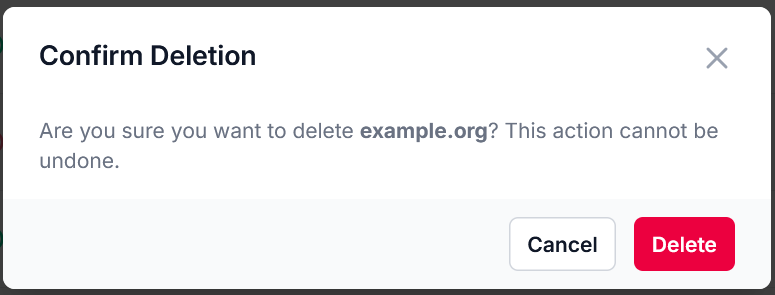Deleting Domains
This guide explains how to remove domains from your UK DNS Privacy Project authoritative DNS service and outlines important considerations before deletion.
Before You Delete a Domain
Deleting a domain from the UK DNS Privacy Project service has several important implications. Before proceeding with deletion, consider the following:
- Service Interruption: If the domain is actively using our nameservers, deleting it will eventually cause DNS resolution failure
- Record Loss: All DNS records associated with the domain will be permanently deleted
- Analytics Loss: All historical query data and analytics for the domain will be permanently deleted
- Irreversible Action: Domain deletion cannot be undone - you will need to recreate the domain and all its records if needed later
When to Delete a Domain
Appropriate scenarios for domain deletion include:
- You no longer own the domain
- You’ve transferred DNS management to another provider
- You’re consolidating domains and this one is no longer needed
- You created the domain for testing purposes only
Preparing for Domain Deletion
Before deleting a domain, it’s recommended to:
- Export DNS Records: Take a backup of your current DNS configuration
- Update Nameservers: If you plan to keep using the domain with another DNS provider, change the nameservers at your registrar before deletion
- Check Dependencies: Ensure no critical services depend on the DNS records you’re about to delete
Deleting a Domain
Step 1: Access the Domains List
- Log in to your UK DNS Privacy Project dashboard
- Navigate to Dashboard > Authoritative Domains
Step 2: Delete the Domain
There are two ways to delete a domain:
Method 1: From the Domains List
- Locate the domain you want to delete in the domains list
- Click the delete (X) icon in the “Actions” column
- A confirmation dialog will appear

Method 2: From the Domain Details Page
- Click on the domain name to access its details page
- Click the Delete Domain button (this may be in a dropdown menu or settings section)
- A confirmation dialog will appear
Step 3: Confirm Deletion
- Read the warning message carefully
- Type the domain name in the confirmation field (if required)
- Click Delete to permanently remove the domain

After Deletion
After a domain is deleted:
- It will be immediately removed from your UK DNS Privacy Project dashboard
- Records will no longer be served from our nameservers
- If your domain’s nameservers are still pointing to our service, DNS resolution will fail
DNS Propagation After Deletion
If you’ve changed nameservers at your registrar before deletion:
- DNS resolution should continue uninterrupted through your new DNS provider
- Allow 24-48 hours for complete propagation to all DNS resolvers
If you’ve deleted the domain without changing nameservers:
- DNS resolution will begin to fail as the deletion propagates
- Some resolvers may continue serving cached records until their TTL expires
Recreating a Deleted Domain
If you need to add the domain back to the UK DNS Privacy Project service:
- Follow the Creating Domains process
- Add your DNS records manually or from a backup
- Update the nameservers at your registrar if necessary
Account-Level Domain Limits
Deleting domains you no longer need helps manage your account’s domain quota:
- Free accounts: Limited number of domains allowed
- Paid accounts: Higher domain limits based on your subscription tier
Deleting unused domains ensures you have capacity available for new domains when needed.
Special Considerations
Subdomains
When deleting a parent domain:
- All associated subdomains will also be deleted
- Ensure you’ve backed up records for any subdomains you may want to recreate later
DNSSEC-Enabled Domains
If the domain has DNSSEC enabled:
- Delete any DS records at your registrar before deleting the domain
- Failure to remove DS records could cause DNSSEC validation failures if you recreate the domain
Troubleshooting
“Cannot Delete Domain” Error
If you receive an error when attempting to delete a domain:
- Verify you have the necessary permissions for your account
- Check if the domain has special protections enabled that prevent deletion
- Contact support if the issue persists